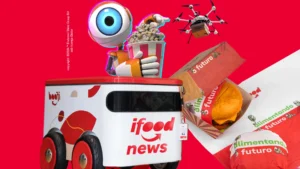The world's largest technology event showcases the latest innovations in foodtech
Robots that deliver food at home or to the restaurant table, make coffee and chat with the customer while preparing their drink were some of the new features in the foodtech section of CES 2022, the largest technology fair in the world, held between January 5th and 7th. in the United States.
In the delivery sector, delivery robots were highlighted. A Carbon Origins He showed his Skippy, which runs along neighborhood sidewalks making deliveries with a trunk on wheels that has a heated compartment and a refrigerated compartment.
He also uses the artificial intelligence to avoid obstacles: its neural network detects and classifies objects and understands which are safe zones to travel through. This neural network is fed, in real time, by a team of humans who use virtual reality technology to remotely guide Skippy's work and provide data about what they see.
Already the Ottonomy showcased its award-winning autonomous robot, powered by electricity and with a thousand and one uses. The machine is capable of delivering food and packages indoors and outdoors. They have already been used to transport purchases from the market to customers' cars and in last mile delivery (both food and retail).
Smart cabinets
In times of Covid-19, smart cabinets for receiving food at home or at the company without contact with delivery people were also present. The creators of Fresh Portal showed their residential prototype of a temperature-controlled box to store home-delivered food even when residents are not there. Delivery people receive a single-use code to open the box and residents use the app to control their temperature remotely while they arrive.
For companies and condominiums, the Minnow demonstrated its Minnow Pickup Pod, which works like this: the consumer orders food online, as usual. Upon arrival, the delivery person scans the QR Code on the cabinet, leaves the food in the compartment and the person who ordered uses their phone to unlock the door and collect the meal. Another solution, OrderHQ, from Apex Order Pickup Solutions, is a smart food delivery locker with hot and cold storage that works in a similar way.
In the market delivery sector, the Northfork showed its white label platform for companies that features recipes made with ingredients that can be purchased online — a solution that has already been used in the United States by the Tasty channel in partnership with Walmart.
Robots in food service
In addition to deliveries, the robots also showed at the fair that they know how to make ramen, pizza and coffee. The autonomous restaurant Yo-Kai Express promises to deliver a hot ramen in 45 seconds, while the automated station Picnic Follow the recipe and prepare up to 100 pizzas per hour in the restaurant kitchen. To finish, just order a coffee at Yummy Future, a kiosk where machines prepare and serve drinks in 30 seconds (sweets are included).
Another new feature was the appearance of the virtual bartender Cecilia. She doesn't work behind the counter, but inside a machine that receives orders via voice command and starts preparing the drink while Cecilia chats with the customer (according to the manufacturer, she is capable of making 120 cocktails per hour ).
Robot waiters also showed service. LG presented the CLOi, capable of bringing three trays to tables at the same time using cameras and sensors to avoid obstacles. Servi, from Bear Robotics, delivers drinks and food to the table and can also be used by staff to collect dishes when customers have finished eating.
Innovation in the kitchen
The foodtech sector at the fair also brought technology into our kitchen. An interesting gadget to reduce food waste at home was the Uvera, which combines ultraviolet light and vacuum packaging to eliminate microorganisms in fresh food and increase its shelf life. According to the manufacturer, this doubles the shelf life of the food.
And, for those looking for an alternative to meat, the Goodside Foods went to the fair to show a type of ground “meat” made from pea and rice protein fermented by shiitake roots and mycelia (part of the fungus). The process, developed by Myco Technology, facilitates the digestion of proteins and extends the shelf life of the food, even without refrigeration, according to the companies.


